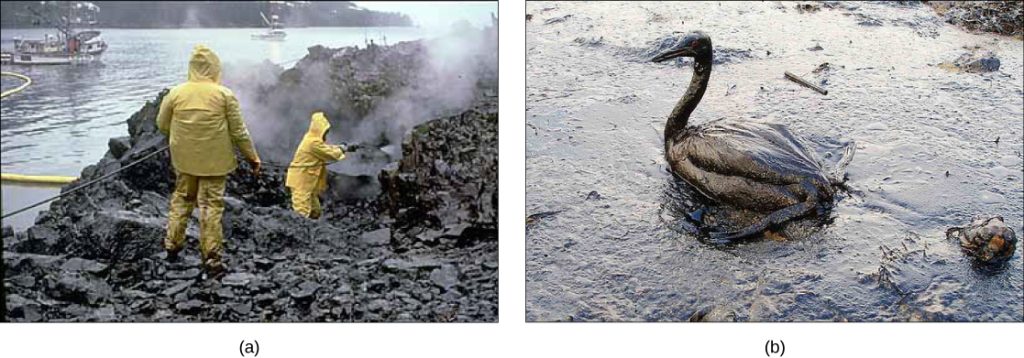6.5 Bioremediation
Section Goals:
- Review examples of events that require remediation.
- Compare bioremediation with other types of remediation.
- Understand what types of organisms contribute to bioremediation.
Examples of Remediation
There are thousands of examples of places where accidental, purposeful, or mismanaged actions caused contamination of soils, waters, or ecosystems. Contamination from petroleum products, due to their hydrophobic nature and natural contaminants contained within them, are unfortunately common at local scales (like underground storage tanks leaking) and massive scales; stark examples such as the Exxon Valdez spill in Alaska, the Deepwater Horizon Spill, and the long-term leak at a oil platform owned by Taylor Energy, both in the Gulf of Mexico, highlight the extensive damage that can occur. Heavy metal contamination is another category of contamination that causes major health concerns, most specifically due to bioaccumulation. Top metal pollutants in the United States of America include arsenic, lead, mercury, cadmium, and chromium. The most common treatment for metal-contaminated sites is to remove the contaminated material, and landfill it somewhere else. Though this method is immediate, it is also ecologically disruptive, costly, and the contaminant is still located somewhere, just theoretically in a place that poses less danger to human health.
Bioremediation
Bioremediation is a waste management technique that involves the use of organisms such as plants, bacteria, and fungi to remove or neutralize pollutants from a contaminated site. According to the United States EPA, bioremediation is a “treatment that uses naturally occurring organisms to break down hazardous substances into less toxic or non toxic substances”.
Bioremediation is widely used in situations that may not seem worthy of “remediation”; such as to treat human sewage and to remove agricultural chemicals (pesticides and fertilizers) that leach from soil into groundwater. Certain toxic metals, such as selenium and arsenic compounds, can also be removed from water by bioremediation. Mercury is an example of a toxic metal that can be removed from an environment by bioremediation. Mercury is an active ingredient of some pesticides and is also a byproduct of certain industries, such as battery production. Mercury is usually present in very low concentrations in natural environments but it is highly toxic because it accumulates in living tissues. Several species of bacteria can carry out the biotransformation of toxic mercury into nontoxic forms. These bacteria, such as Pseudomonas aeruginosa, can convert Hg2+ to Hg, which is less toxic to humans.
Probably one of the most useful and interesting examples of the use of prokaryotes for bioremediation purposes is the cleanup of oil spills. The importance of prokaryotes to petroleum bioremediation has been demonstrated in several oil spills, such as the Exxon Valdez spill in Alaska (1989) (Figure 1), the Prestige oil spill in Spain (2002), the spill into the Mediterranean from a Lebanon power plant (2006). To clean up these spills, bioremediation is promoted by adding inorganic nutrients that help bacteria already present in the environment to grow.

Specific ways that bacteria mitigate oil spills include breaking the oil down into smaller, inorganic components, and degrading the oil fully to carbon dioxide. Hydrocarbon-degrading bacteria feed on the hydrocarbons in the oil droplet, breaking them into inorganic compounds. Some species, such as Alcanivorax borkumensis, produce surfactants that solubilize the oil, while other bacteria degrade the oil into carbon dioxide. In the case of oil spills in the ocean, ongoing, natural bioremediation tends to occur, inasmuch as there are oil-consuming bacteria in the ocean prior to the spill. Under ideal conditions, it has been reported that up to 80 percent of the nonvolatile components in oil can be degraded within 1 year of the spill.
Researchers have genetically engineered other bacteria to consume petroleum products; indeed, the first patent application for a bioremediation application in the U.S. was for a genetically modified oil-eating bacterium.
There are a number of cost/efficiency advantages to bioremediation, which can be employed in areas that are inaccessible without excavation. For example, hydrocarbon spills (specifically, oil spills) or certain chlorinated solvents may contaminate groundwater, which can be easier to treat using bioremediation than more conventional approaches. This is typically much less expensive than excavation followed by disposal elsewhere, incineration, or other off-site treatment strategies. It also reduces or eliminates the need for “pump and treat”, a practice common at sites where hydrocarbons have contaminated clean groundwater. Using prokaryotes for bioremediation of hydrocarbons also has the advantage of breaking down contaminants at the molecular level, as opposed to simply chemically dispersing the contaminant.
Attribution
Beneficial Prokaryotes by OpenStax is licensed under CC BY 4.0. Modified from originals by Matthew R. Fisher and Joni Baumgarten.
EPA Oil Spill Guide by the United States Environmental Protection Agency is licensed CC-BY. Modified from original by Joni Baumgarten

